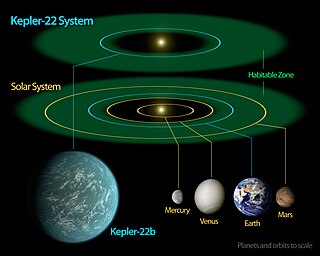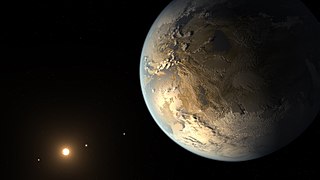
Kepler-22b is an exoplanet orbiting within the habitable zone of the Sun-like star Kepler-22. It is located about 640 light-years from Earth in the constellation of Cygnus. It was discovered by NASA's Kepler Space Telescope in December 2011 and was the first known transiting planet to orbit within the habitable zone of a Sun-like star, where liquid water could exist on the planet's surface. Kepler-22 is too dim to be seen with the naked eye.

Gliese 667 Cc is an exoplanet orbiting within the habitable zone of the red dwarf star Gliese 667 C, which is a member of the Gliese 667 triple star system, approximately 23.62 light-years away in the constellation of Scorpius. The exoplanet was found by using the radial velocity method, from radial-velocity measurements via observation of Doppler shifts in the spectrum of the planet's parent star.

Kepler-47c is an exoplanet orbiting the binary star system Kepler-47, the outermost of three such planets discovered by NASA's Kepler spacecraft. The system, also involving two other exoplanets, is located about 3,400 light-years away.

Kepler-69c is a confirmed super-Earth extrasolar planet, likely rocky, orbiting the Sun-like star Kepler-69, the outermore of two such planets discovered by NASA's Kepler spacecraft. It is located about 2,430 light-years from Earth.

Kepler-62e is a super-Earth exoplanet discovered orbiting within the habitable zone of Kepler-62, the second outermost of five such planets discovered by NASA's Kepler spacecraft. Kepler-62e is located about 990 light-years from Earth in the constellation of Lyra. The exoplanet was found using the transit method, in which the dimming effect that a planet causes as it crosses in front of its star is measured. Kepler-62e may be a terrestrial or ocean-covered planet; it lies in the inner part of its host star's habitable zone.

Kepler-62f is a super-Earth exoplanet orbiting within the habitable zone of the star Kepler-62, the outermost of five such planets discovered around the star by NASA's Kepler spacecraft. It is located about 980 light-years from Earth in the constellation of Lyra.
Kepler-62c is an approximately Mars-sized exoplanet discovered in orbit around the star Kepler-62, the second innermost of five discovered by NASA's Kepler spacecraft around Kepler-62. At the time of discovery it was the second-smallest exoplanet discovered and confirmed by the Kepler spacecraft, after Kepler-37b. It was found using the transit method, in which the dimming that a planet causes as it crosses in front of its star is measured. Its stellar flux is 25 ± 3 times Earth's. It is similar to Mercury.
Kepler-62d is the third innermost and the largest exoplanet discovered orbiting the star Kepler-62, with a size roughly twice the diameter of Earth. It was found using the transit method, in which the dimming that a planet causes as it crosses in front of its star is measured. Its stellar flux is 15 ± 2 times Earth's. Due to its closer orbit to its star, it is a super-Venus or, if it has a volatile composition, a hot Neptune, with an estimated equilibrium temperature of 510 K, too hot to sustain life on its surface.
Kepler-61b is a super-Earth exoplanet orbiting within parts of the habitable zone of the K-type main-sequence star Kepler-61. It is located about 1,100 light-years from Earth in the constellation of Cygnus. It was discovered in 2013 using the transit method, in which the dimming effect that a planet causes as it crosses in front of its star is measured, by NASA's Kepler spacecraft.

Kepler-90h is an exoplanet orbiting within the habitable zone of the early G-type main sequence star Kepler-90, the outermost of eight such planets discovered by NASA's Kepler spacecraft. It is located about 2,840 light-years, from Earth in the constellation Draco. The exoplanet was found by using the transit method, in which the dimming effect that a planet causes as it crosses in front of its star is measured.
Kepler-61 is a K-type main-sequence star approximately 1,100 light years from Earth in the constellation Cygnus. It is located within the field of vision of the Kepler spacecraft, the satellite that NASA's Kepler Mission used to detect planets that may be transiting their stars. On April 24, 2013 it was announced that the star has an extrasolar planet orbiting in the inner edge of the habitable zone, named Kepler-61b.

Kepler-186f is an Earth-sized exoplanet orbiting within the habitable zone of the red dwarf star Kepler-186, the outermost of five such planets discovered around the star by NASA's Kepler spacecraft. It is located about 580 light-years from Earth in the constellation of Cygnus.

Kepler-438b is a confirmed near-Earth-sized exoplanet. It is likely rocky. It orbits on the inner edge of the habitable zone of a red dwarf, Kepler-438, about 472.9 light-years from Earth in the constellation Lyra. It receives 1.4 times our solar flux. The planet was discovered by NASA's Kepler spacecraft using the transit method, in which the dimming effect that a planet causes as it crosses in front of its star is measured. NASA announced the confirmation of the exoplanet on 6 January 2015.

Kepler-442b is a confirmed near-Earth-sized exoplanet, likely rocky, orbiting within the habitable zone of the K-type main-sequence star Kepler-442, about 1,206 light-years (370 pc) from Earth in the constellation of Lyra.

Kepler-452b is a super-Earth exoplanet orbiting within the inner edge of the habitable zone of the sun-like star Kepler-452 and is the only planet in the system discovered by Kepler. It is located about 1,400 light-years (430 pc) from Earth in the constellation of Cygnus.

Kepler-452 is a G-type main-sequence star located about 1,810 light-years away from Earth in the Cygnus constellation. Although similar in temperature to the Sun, it is 20% brighter, 3.7% more massive and 11% larger. Alongside this, the star is approximately six billion years old and possesses a high metallicity.
Kepler-419c is a super-Jupiter exoplanet orbiting within the habitable zone of the star Kepler-419, the outermost of two such planets discovered by NASA's Kepler spacecraft. It is located about 3,400 light-years from Earth in the constellation Cygnus. The exoplanet was found by using the transit timing variation method, in which the variations of transit data from an exoplanet are studied to reveal a more distant companion.
Kepler-1229 is a red dwarf star located about 870 light-years (270 pc) away from the Earth in the constellation of Cygnus. It is known to host a super-Earth exoplanet within its habitable zone, Kepler-1229b, which was discovered in 2016.

K2-72e (also known by its EPIC designation EPIC 206209135.04), is a confirmed exoplanet, likely rocky, orbiting within the habitable zone of the red dwarf star K2-72, the outermost of four such planets discovered in the system by NASA's Kepler spacecraft on its "Second Light" mission. It is located about 217.1 light-years (66.56 parsecs, or nearly 2.0538×1015 km) away from Earth in the constellation of Aquarius. The exoplanet was found by using the transit method, in which the dimming effect that a planet causes as it crosses in front of its star is measured.

Habitability of yellow dwarf systems defines the suitability for life of exoplanets belonging to yellow dwarf stars. These systems are the object of study among the scientific community because they are considered the most suitable for harboring living organisms, together with those belonging to K-type stars.


















